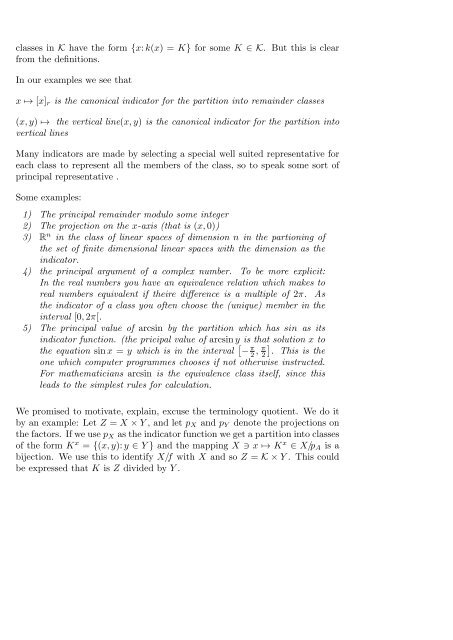ABSTRACT ALGEBRAIC STRUCTURES OPERATIONS AND ...
ABSTRACT ALGEBRAIC STRUCTURES OPERATIONS AND ...
ABSTRACT ALGEBRAIC STRUCTURES OPERATIONS AND ...
You also want an ePaper? Increase the reach of your titles
YUMPU automatically turns print PDFs into web optimized ePapers that Google loves.
classes in K have the form {x: k(x) = K} for some K ∈ K. But this is clear<br />
from the definitions.<br />
In our examples we see that<br />
x ↦→ [x]r is the canonical indicator for the partition into remainder classes<br />
(x, y) ↦→ the vertical line(x, y) is the canonical indicator for the partition into<br />
vertical lines<br />
Many indicators are made by selecting a special well suited representative for<br />
each class to represent all the members of the class, so to speak some sort of<br />
principal representative .<br />
Some examples:<br />
1) The principal remainder modulo some integer<br />
2) The projection on the x-axis (that is (x, 0))<br />
3) Rn in the class of linear spaces of dimension n in the partioning of<br />
the set of finite dimensional linear spaces with the dimension as the<br />
indicator.<br />
4) the principal argument of a complex number. To be more explicit:<br />
In the real numbers you have an equivalence relation which makes to<br />
real numbers equivalent if theire difference is a multiple of 2π. As<br />
5)<br />
the indicator of a class you often choose the (unique) member in the<br />
interval [0, 2π[.<br />
The principal value of arcsin by the partition which has sin as its<br />
indicator function. (the pricipal value of arcsin y is that solution x to<br />
the equation sin x = y which is in the interval [ − π<br />
]<br />
π<br />
2 , 2 . This is the<br />
one which computer programmes chooses if not otherwise instructed.<br />
For mathematicians arcsin is the equivalence class itself, since this<br />
leads to the simplest rules for calculation.<br />
We promised to motivate, explain, excuse the terminology quotient. We do it<br />
by an example: Let Z = X × Y , and let pX and pY denote the projections on<br />
the factors. If we use pX as the indicator function we get a partition into classes<br />
of the form K x = {(x, y): y ∈ Y } and the mapping X ∋ x ↦→ K x ∈ X/pA is a<br />
bijection. We use this to identify X/f with X and so Z = K × Y . This could<br />
be expressed that K is Z divided by Y .
















